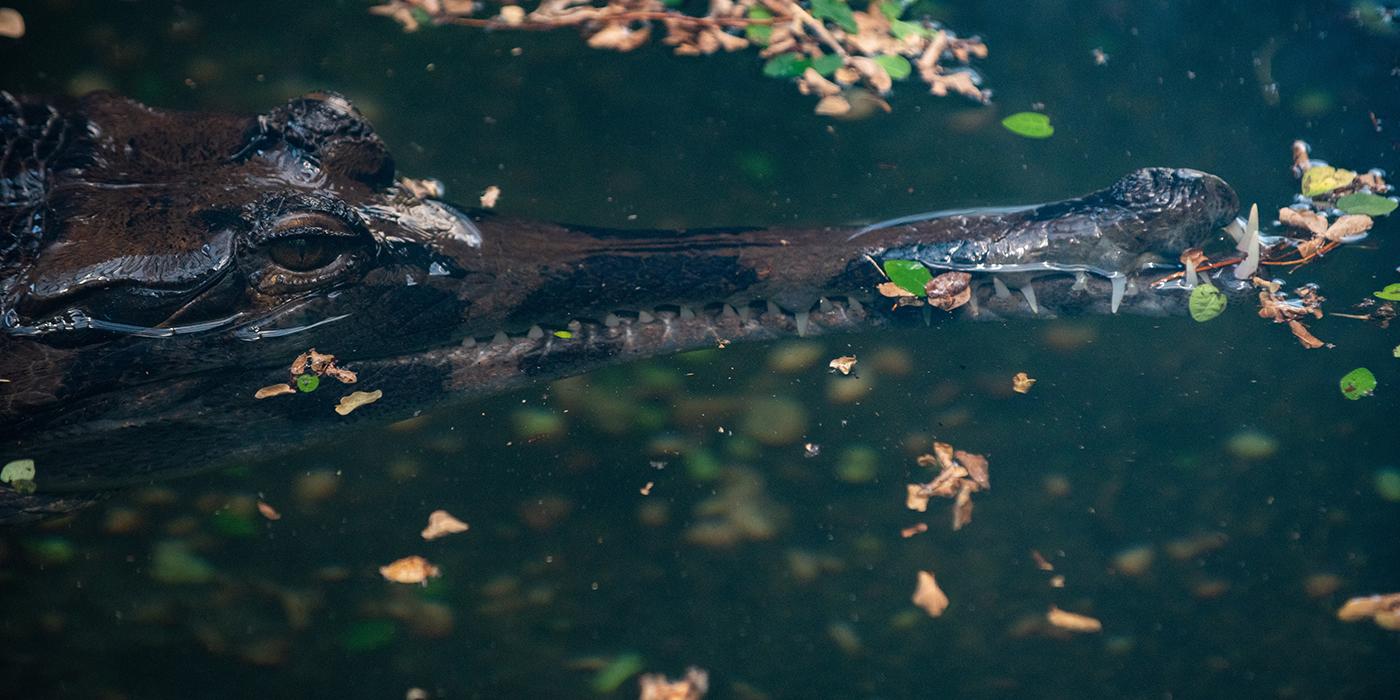Physical Description
Tomistoma have characteristically long, narrow snouts. Hatchlings are born countershaded. They are dark brown dorsally (their backs) with a light cream color ventrally (their bellies). Hatchlings also have black bands on their tails and bodies, and dark blotches on their jaws. Adults retain much of this coloration but are traditionally lighter or reddish brown dorsally.
Size
Male tomistoma can grow up to 16 feet (5 meters) long.
Native Habitat
Native to Indonesia and Malaysia, false gavials can be found in eastern Sumatra, Kalimantan and western Java in Indonesia, as well as in parts of Peninsular Malaysia and Sarawak in Malaysia. It is thought that they once occurred in Thailand; however there have been no recorded sightings since the 1970s.
This freshwater species is found predominantly in lakes, swamps and rivers, with a significant number of sightings occurring in peat swamps and freshwater swamp forests. It prefers slow-moving water and an abundance of vegetation in its habitat.
Food/Eating Habits
The tomistoma's long, narrow snout helps it catch fish; this adaptation allows for less resistance as the snout cuts through water.
Tomistoma are thought to have a generalized diet in the wild, consuming a variety of fish, insects, crustaceans and small mammals. While most of their mammalian prey is on the smaller side, tomistoma have been reported to take on species as large as macaque monkeys.
At the Smithsonian's National Zoo, tomistoma eat chicken, fish, rats and crocodile pellets.
Reproduction and Development
Fewer than 20 tomistoma nests have been recorded in the wild, so there is limited information on the reproductive habits of this species. Trends from these nests have found nest placement occurring up streams at the base of trees, near cultivated land or possibly on floating vegetation.
A clutch normally consists of 20 to 30 eggs. There is no evidence to indicate that hatchlings receive parental care, which is an unusual trait in crocodilians. Female sexual maturity is determined by size, and is reached at approximately 8-10 feet (2.5-3 meters).
Conservation Efforts
More research is needed on the status of tomistoma in the wild, but their population is cautiously estimated at fewer than 2,500 mature individuals. They are considered to have a relatively wide range throughout Indonesia and Malaysia but occur at low densities. In addition to the International Union for Conservation of Nature's Red List, this species is also listed on CITES Appendix I.
As with many animals, their greatest threat is habitat destruction, specifically from dam construction and deforestation. Intense hunting throughout the mid-20th century has also taken its toll on tomistoma. Currently, some fishing practices also impact the remaining wild populations. Tomistoma have been discovered caught in nets, or have died after ingesting toxins used to kill fish.
While many tomistoma live in protected areas, additional research is still needed to take appropriate action to conserve this species.
Help this Species
- Be a smart consumer! Avoid animal-skin products, even those marked “faux,” to ensure you’re not contributing to the illegal hunting of this species.
- Practice ecotourism by being an advocate for the environment when you’re on vacation. During your travels, support, visit or volunteer with organizations that protect wildlife. Shop smart too! Avoid buying products made from animals, which could support poaching and the illegal wildlife trade.
- Share the story of this animal with others. Simply raising awareness about this species can contribute to its overall protection.
Meet the Animals
The Smithsonian's National Zoo's is home to one female tomistoma. This very special animal is one of only a few tomistoma that have successfully hatched in the U.S. Her nickname, Pip, was chosen because she was the only hatchling in her clutch to pip, or break out of the egg, and survive. Pip is about 7 feet long but is still young. When she is older, she could grow up to 16 feet long.
Animal News

#DCPandas: Happy 4th Birthday, Qing Bao! ›

Canada Lynx Have Arrived at the Smithsonian’s National Zoo ›

